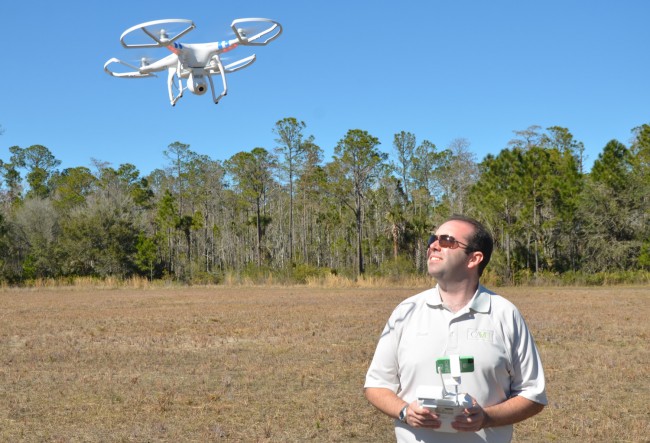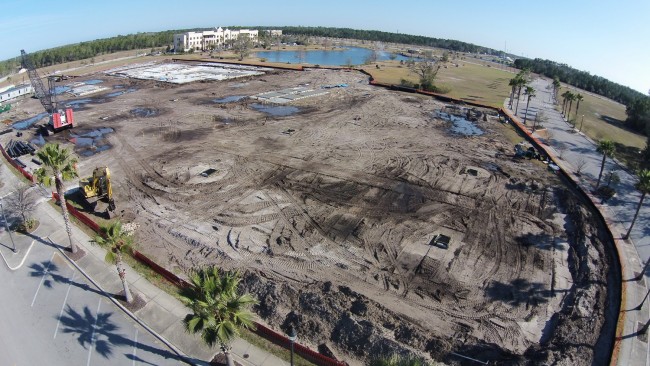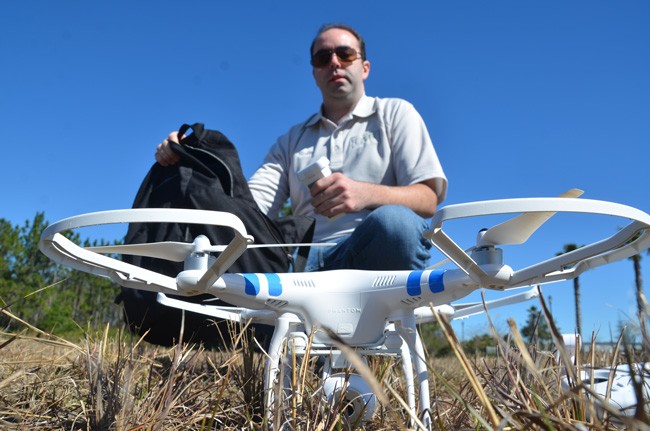
Colleen Calnan of Calnan Real Estate in Flagler and Volusia had been reading about drones—not the ones the CIA sends over Afghanistan and Yemen with Hellfire missiles, but tiny ones private companies are flying Stateside to help companies like hers sell property.
Scott Barry, who last August opened the Palm Coast operation of CAVU Aerial Photography, a drone-flying company in eight cities across the country, was prospecting for clients. He met up with Calnan.
“I had a couple of properties I thought would really benefit from that type of technology,” Calnan said of drone-shot video, “because one was a small horse farm with lots of acreage, which ground shots couldn’t really show the potential of the property, another one was a riverfront condominium,” its front side not as attractive as its riverfront profile. “He went out and did the shots for me, and instantly I started attracting more viewers online.”
To Realtor Rick Hose of locally-based Exit Real Estate Property Solutions, CAVU’s drone footage was directly responsible for the sale of a 16-acre property in Osteen. “He was able to take the drone over the lake and all over the property,” Hose said, “even above the wooded areas, so they can see different cleared out areas, where different ponds were,” something Google Earth’s imagery is incapable of because it doesn’t get low enough for the details.
Hose works with a lot of out of state clients. They can’t easily walk a big property or see it from every angle. Whether it’s providing them “every view I possibly can of the area” or giving prospective condominium buyers an actual view of what it will look from a higher floor, even before its built—many condos don’t go up until 50 percent of the space has been sold—drone footage is ideal, high-quality and cheap: he paid $100 for edited footage of a $100,000 house. CAVU’s charges for a shoot range anywhere from $35 to $700.
FAA Rules Invite Trove of Civilian Uses
Those are just a couple of examples of how the drone industry, non-existent just a few years ago and highly suspect until recently, is very rapidly becoming a mainstream commodity that may soon become routinely essential to business. The Federal Aviation Administration took note.
Today’s Federal Register is publishing the FAA’s proposed rules that would regulate drone use in domestic air space and essentially free drone pilots from previous, more onerous rules that had treated them no differently than airplane pilots—and therefore kept drones grounded for most. (See the complete proposed rules below the article.)
To Barry, the rules are a as good as a gift.
CAVU’s Drone Captures a County Road 304 Property in Bunnell
“It’s actually very good news for our industry and was really exactly what we were hoping would be passed down,” the 29-year-old entrepreneur said. “The initial proposal of the FAA that was leaked out a while ago gave us all the impression that in order to fly a drone, we would need to be licensed pilots, as in airplane pilots. We would have to go through the same training classes and be licensed the same way anybody flying an airplane would be. Our drones that the majority of our industry utilizes are in the 10 pounds or less or 5 pounds or less range, so they weren’t really distinguishing the difference. Now what they’ve released is a simple knowledge test to be taken every 24 months at an FAA site, and a fee to be licensed.” The rest is common sense.
Barry and his colleagues—“buddies,” he calls them—established CAVU Aerial Photography in Chicago, where the office was launched by Dan Isaacson. The name of the company is an acronym for Ceiling and Visibility Unlimited, a term used in aviation and weather forecasting. CAVU It’s now in eight cities, Palm Coast among them: Barry uses his home base locally to cover much of central and northeast Florida. The company’s focus right now is realtors, but the FAA’s new rules are about to open vast new possibilities.
“Other industries have been inquiring about our services and have been waiting on these regulations to be released,” Barry says. “Some power companies are wanting to utilize us to complete cell tower surveys, which right now require people to climb up to the top of them and survey each aspect of the tower, which is a very dangerous and costly thing for them. So utilizing a drone to go up and complete this, and then they have the video and photos that they can review again and again, they then determine whether they need to send somebody up to repair, instead of multiple trips up a tower. That’s an issue that’s really been chomping at the bit for these regulations to come out. And then other surveying options, such as governments using us for land surveys, environmental surveys, there’s the use of commercial real estate and development and industrial as well.”
Policing Privacy
Barry operates a DJI Phantom, one of the more popular and accessible drones, retailing for around $1,200—a quiet, buzzing little creature that a child could carry and whose quartet of propellers sends it zipping in every direction Barry Wills it in a couple of eye blinks. It can fly for up to 20 minutes on a battery charge, though Barry doesn’t take it to that limit. He demonstrated the machine’s capabilities in a flight next to the site where Palm Coast’s future city hall is going up, with, for the first time at that site, impressive imagery that showed the expanse of the work site and its context in Town Center.

Privacy issues have been limited. Barry ran into one such issue while shooting for a client in another county. “Someone did have some questions, they were perfectly in their right to ask them,” he said. “We weren’t shooting into anybody’s property. It was something that the complex was aware of, we had permission to be there and it was all smoothed over. I only had one person ask questions. Typically it’s excitement and curiosity. People are excited about this neat technology that’s out there.”
“I think it’s fabulous technology,” Calnan said. “Of course it’s not right for every property but we have a lot of unique properties in our area where ground photography doesn’t highlight the scope of the property and the advantage of owning that property.”
Florida two years ago banned the use of drones by local, county or state police at a time when drones were starting to enter the arsenal of police forces. The Legislature passed the ban with near unanimity and Gov. Rick Scott signed it into law. It’s not an outright ban: police can still use drones in limited circumstances, with a warrant, but in cases where danger is imminent. The law did not address private-sector use of drones, which have been spreading
To fly a drone, public agencies have been required to obtain a Certificate of Waiver or Authorization from the FAA, which nationally issued 146 such COAs in 2009, double the number in 2010, and 373 as of October 2013. In all, there were 545 active COAs as of December 2013.
Predictions of a Drone Boom
“Industry forecasts predict drones will create tens of billions of dollars in economic development and create thousands of new jobs once commercial use is permitted,” the New York Times reported when the FAA first announced its proposed rules in January. But the public has been more skeptical, with an Associated Press poll in December showing that just 21 percent of respondents favored the use of drones for commercial purposes, with 43 percent opposed and 35 percent in the middle.
The Association for Unmanned Vehicle Systems International, the trade group lobbying on the industry’s behalf, claims the FAA’s rules will unleash the industry’s economic potential, with an economic impact “expected to be $82 billion in the 11 years following integration. The total job creation by 2025 is estimated to be more than 100,000.”
Drones as the FAA sees them can have numerous uses locally. They can be used to inspect or monitor crops, power lines, antennas and bridges, they can be used in research and education, for aerial photography, by rescuers trying to locate victims in hilly or inaccessible terrain, and for wildlife evaluations, as when, locally, manatees are counted annually from the air.
“The use of small unmanned aircraft would avert potential fatalities and injuries to those in the aircraft and on the ground,” the FAA wrote in its proposed rule briefing. “It would also lead to more efficient methods of performing certain commercial tasks that are currently performed by other methods.”
The New Rules
Current rules require operators of drones to have either a private or a commercial pilot license. That requirement, which the FAA calls “an unnecessary burden for many small UAS operations,” would be eliminated. (UAS is the acronym for Unmanned Aircraft System). The proposed rules are extensive, but practically can be summarized as follows, keeping in mind that there are separate rules for drones of up to 55 pounds and “micro” drones that don’t exceed 4.4 pounds. Micro-drones must disintegrate on impact and therefore be built of breakable plastic, wood, paper and foam.
- Drone operators must be at least 17, be tested every 24 months by the FAA and vetted by the Transportation Security Administration. Operators of micro-drones need only “self-certify.” No tests required.
- The drone must weigh less than 55 pounds, or 4.4 pounds for micro-drones.
- It must remain in the operator’s line of sight at all times.
- The larger drone may not be flown over people not directly involved in the flying operation, but flying micro-drones over people is
- Daylight flying only.
- Maximum speed may not exceed 100 mph (87 knots) for regular drones and maximum altitude may not exceed 500 feet, or 400 feet and speeds of 30 knots for micro-drones.
- Drones may not be operated from moving vehicles or aircraft, but notably may be operated from boats—except for micro-drones, which may not be flown from any moving vehicle, boats included.
- Micro-drones must be flown at no less than a 5-mile distance from any airport.
The proposed rules don’t apply to model aircraft. Of course there are risks: drones crash. But the crash of a 50-pound machine is considerably less damaging than the crash of a machine weighing from 1,300 to 6,000 pounds, the FAA notes. “Consequently, because a small unmanned aircraft is significantly lighter than a manned aircraft, in the event of a mishap, the small unmanned aircraft would pose significantly less risk to persons and property on the
Ground,” the FAA writes. “As such, a small UAS operation whose parameters are well defined so it does not pose a significant risk to other aircraft would also pose a smaller overall public risk or threat to national security than the operation of a manned aircraft.”
The FAA is taking public comment on the proposed rules, which appear in full below, for 60 days starting Feb. 23. You can leave a comment electronically by going to this site and entering this code in the search box: FAA-2015-0150, or go here.
![]()
Proposed FAA Rules for Drones, 2015






























PCOG says
A five pound object falling out of the sky can easily kill a person. These entrepreneurs better make sure our residents stay safe or they will have problems. How many accidents did we have recently with private planes hitting homes and businesses? Exactly. Now residents not only have to worry about hobbyists flying out of Flagler Airport and crashing into their homes, we have to worry about dozens of these things over our heads. They better keep them far away from my home or they will have trouble.
Just me says
” How many accidents did we have recently with private planes hitting homes and businesses? ”
Not many when you add up all the flyts across our nation or County. Its a very very small % of all the planes in the air. And just what do you mean by ~” They better keep them far away from my home or they will have trouble.” What kind of threat is it you are putting out there?
ted bundy says
who pays for the damage when a drone crashes and injures someone or someones property? what if someone gets killed by a falling drone? is there an insurance requirement? these are real world questions that MUST be answered!!!????
Give me Liberty says
Since our privacy is once again STOLEN from us, its only fair to remove these Peeping Toms “down” anyway we can. Slingshots…Buckshot…Electrical Pulse shot…….These is going to be FUN !!!!
Brad says
That is great news with a ton of great business opportunities. Very cool.
confidential says
Lets see what the FAA comes up with…? I do not like the idea of one of this things flown by my neighbor in our residential areas spying in our windows. Enough with those fly boys making stunts overhead out of the FCA.
David B. says
A lot of things can now be seen from the air, that could not or did not be seen from the ground. This is good.
Favors UAV says
I remember back in the day when Cameras were introduced to cell phone and it began an outrage from narrow minded people saying “People can spy on people now…” and the like. Now it is a standard in phones while the nay-sayers seldom exist.
Every decade there is technology that amazes the world. The more it gains popularity like a celebrity, the more there will be haters.
My suggestions to YOU nay-sayers is instead of complaining about it, why not help make it safer for the communities? Because whether you like it or not, Unmanned Aerial Vehicles (UAV’s), drones, quadcopters, etc… are here to stay and it’s only getting bigger. So face the music and help the industry be a safe one. Not everyone is bad.
I’ve been in this hobby a while and enjoy it. I enjoy so much that I’d like to start a business in educating people that want to learn how to build, repair and fly the safest way possible (soon hopefully). I fly my little quad in my front lawn and my neighbors don’t mind it. I fly safe and away from people and I don’t “spy” through windows.
If you Don’t know the industry very well, please feel free to ask questions to people who do. We are more willing to pass knowledge to you so a better judgement of this hobby is better understood.
JW says
This was a good article. There’s so much ignorance and hype when it comes to the word “drone”. Just look at the comments posted right here! Ignorance and fear. As drones become more common and people get more educated there will be a lot less people freaking out. Safe and responsible users are an absolute must, but I’m confident this technology will save far more lives than it will endanger.